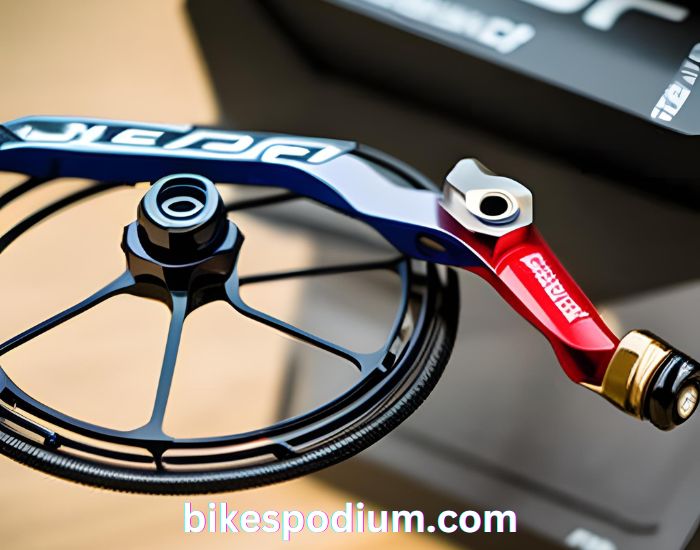
Mountain biking is an exhilarating sport that requires regular maintenance to ensure peak performance and safety. One crucial aspect of maintaining your mountain bike is bleeding the brakes. Properly functioning brakes are essential for controlling speed and maintaining control on the trails. In this article, we will discuss how often you should bleed your MTB brakes and provide you with a comprehensive guide on the process.
Importance of Bleeding MTB Brakes
Before we dive into the frequency of brake bleeding, let’s understand why it is crucial. Hydraulic disc brakes, commonly found on mountain bikes, utilize a closed system filled with hydraulic fluid to transmit force from the brake lever to the brake caliper. Over time, air bubbles can infiltrate the system, leading to a spongy or inconsistent brake feel.
Bleeding the brakes removes any air bubbles or contaminants from the hydraulic system, ensuring optimal brake performance. Regular bleeding not only improves braking power but also enhances modulation and lever feel, allowing you to tackle technical trails with confidence.
Improved Braking Power
When air bubbles or contaminants enter the hydraulic system, they can cause a loss of braking power. This can be dangerous, especially when riding on steep descents or in challenging terrain. By bleeding your MTB brakes regularly, you can ensure that the system is free from any air bubbles or contaminants that may compromise the braking power of your bike.
Enhanced Modulation and Lever Feel
In addition to improving braking power, bleeding the brakes also enhances modulation and lever feel. Modulation refers to the ability to control the amount of braking power applied. When the brakes are properly bled, you can have more precise control over your bike’s speed, allowing you to navigate technical sections of the trail with ease. Additionally, a well-bleed brake system provides a consistent and responsive lever feel, giving you confidence in your ability to stop when needed.
Increased Safety
Maintaining optimal brake performance is crucial for your safety on the trails. By bleeding your MTB brakes regularly, you can prevent any potential issues that may arise from air bubbles or contaminants in the system. This will ensure that your brakes are reliable and responsive, allowing you to ride with peace of mind.
Factors Influencing Brake Bleeding Frequency
The frequency at which you should bleed your MTB brakes depends on several factors. Let’s take a closer look at these factors to determine how often you should perform this maintenance task.
Riding Conditions
The riding conditions play a significant role in determining brake bleeding frequency. If you frequently ride in harsh or muddy environments, your brakes are more likely to accumulate contaminants that can compromise their performance. In such cases, bleeding your MTB brakes more frequently, such as every 6-12 months, is recommended.
Riding in muddy conditions exposes your brakes to dirt, grime, and water, which can lead to contamination of the hydraulic system. The contaminants can affect the brake fluid and cause a decrease in braking power. Therefore, it is crucial to inspect your brakes regularly and bleed them if necessary.
On the other hand, if you primarily ride in dry and clean conditions, you may be able to extend the bleeding interval to 12-24 months. However, it is essential to perform regular checks to ensure your brakes are functioning optimally.
Brake Usage
The amount of use your brakes undergo also affects the bleeding frequency. Aggressive riders who frequently tackle steep descents and engage in heavy braking will put more stress on their brakes, leading to faster brake fluid degradation. In such cases, bleeding your brakes every 6-12 months is advisable.
Frequent use of your brakes generates heat, which can cause the brake fluid to deteriorate over time. This degradation can lead to a decrease in braking power and affect your ability to control your bike effectively. Therefore, it is important to monitor your brake usage and bleed your brakes accordingly.
Conversely, riders who engage in lighter braking or have a more relaxed riding style may be able to prolong the bleeding interval to 12-24 months. However, it is critical to monitor brake performance and be attentive to any changes that may indicate the need for bleeding.
Brake Feel
The most apparent sign that your brakes require bleeding is a spongy or mushy feel at the brake lever. If you notice a lack of bite or inconsistent braking power, it is time to bleed your brakes, regardless of the time elapsed since the last bleeding. Maintaining optimal brake feel is essential for safe riding and precise control.
Brake feel refers to the response and feedback you get from your brakes when applying pressure to the lever. If the brake lever feels spongy or mushy, it indicates the presence of air bubbles in the system. This can significantly affect your ability to modulate and control your braking. Therefore, it is crucial to address any changes in brake feel promptly and bleed your brakes if necessary.
Signs That Indicate the Need for Brake Bleeding
While adhering to a recommended bleeding schedule is ideal, it is also crucial to be aware of signs that indicate the need for immediate brake bleeding. Pay attention to the following red flags:
- Spongy Brake Lever: If your brake lever feels soft and requires excessive effort to engage, it indicates the presence of air bubbles in the system. Bleeding the brakes will remove these air bubbles and restore the proper functioning of your brakes.
- Inconsistent Braking: If your brakes feel unpredictable or lack consistent stopping power, it is a clear indication that air has entered the system, affecting its performance. Bleeding the brakes will eliminate any air bubbles and ensure consistent braking power.
- Brake Fade: If your brakes lose power over extended downhill descents or during prolonged braking, it suggests that your brakes are overheating due to air contamination. Bleeding the brakes will remove the air bubbles and restore the cooling properties of the brake fluid, preventing brake fade.
If you experience any of these signs, do not delay brake bleeding, as it directly impacts your safety on the trails.
How to Bleed MTB Brakes
Now that we have discussed the importance and frequency of brake bleeding let’s delve into the step-by-step process of bleeding MTB brakes. Before we begin, gather the following tools:
- Brake bleeding kit (including bleed funnel, syringe, and brake fluid)
- Allen wrench set
- Clean rags
- Isopropyl alcohol
- Latex gloves
Step 1: Preparation
- Find a well-ventilated area with a flat surface to work on. This will ensure proper ventilation and stability during the bleeding process.
- Put on your latex gloves to protect your hands from brake fluid. Brake fluid can be corrosive, so it is essential to take necessary precautions.
- Clean the bike thoroughly, paying particular attention to the brake calipers and levers, ensuring no dirt or debris interferes with the process. Clean surfaces will prevent contamination of the brake fluid and ensure a smooth bleeding process.
Step 2: Remove Excess Fluid
- Loosen the brake caliper bolts using the appropriate size Allen wrench and gently pry the caliper open to expose the pads. This will allow you to access the bleed port and bleed screws.
- Place a clean rag underneath the caliper to catch any excess brake fluid that may spill during the bleeding process. This will help keep your work area clean and prevent any damage to the bike frame or components.
- Insert the bleed block or a spacer between the brake pads to prevent them from being pushed out during the bleeding procedure. This will ensure that the brake pads remain in position and prevent any damage to the rotor.
Step 3: Connect Bleed Kit
- Connect the bleed funnel to the brake lever bleed port using the provided tubing. Ensure a tight and secure connection to prevent any leakage during the bleeding process.
- Fill the syringe with fresh brake fluid and connect it to the bleed port on the brake caliper. Make sure all connections are secure and tight to avoid any leakage during the process. Brake fluid is essential for the proper functioning of your brakes, so it is important to use the correct fluid recommended by the manufacturer.
Step 4: Begin Bleeding
- Starting from the brake lever, slowly pump the brake lever a few times and hold it in. This will create pressure in the system and prepare it for bleeding.
- While maintaining pressure on the lever, open the bleed port on the caliper slightly using the appropriate wrench. This will allow the air bubbles to escape from the system.
- Observe the brake fluid in the syringe for any air bubbles, and as they appear, tap the brake line to dislodge them. This will help the air bubbles rise to the top and be expelled from the system.
- Once all air bubbles are removed, close the bleed port and release the brake lever. This will complete the bleeding process for that particular section of the brake system.
- Repeat this process, starting from the lever and moving down to the caliper, until the brake fluid appears bubble-free and consistent in color. This will ensure that all sections of the brake system are properly bled and free from air bubbles.
Step 5: Final Checks
- Wipe off any excess brake fluid using a clean rag dampened with isopropyl alcohol. This will remove any residue and ensure a clean and tidy appearance.
- Ensure all connections are tightened and secure. Loose connections can lead to leakage and affect the performance of your brakes.
- Remove the bleed block or spacer from the caliper. This will allow the brake pads to move freely and engage with the rotor when the brakes are applied.
- Squeeze the brake lever a few times to ensure proper engagement and consistent lever feel. This will help you verify that the brakes are functioning as intended.
- Take a short test ride in a safe area to confirm that your brakes are functioning optimally. Test the brakes at different speeds and in various conditions to ensure they provide the desired stopping power and modulation.
Conclusion
Regularly bleeding your MTB brakes is essential for maintaining optimal braking performance and ensuring your safety on the trails. The frequency of brake bleeding depends on various factors, such as riding conditions, brake usage, and brake feel. By paying attention to these factors and promptly addressing any signs that indicate the need for bleeding, you can enjoy an exhilarating mountain biking experience with reliable and responsive brakes. Always remember to follow the manufacturer’s guidelines and seek professional assistance if you are unsure about the brake bleeding process. Happy riding!
FAQ
Q: Why is bleeding MTB brakes important?
A: Bleeding MTB brakes removes air bubbles or contaminants from the hydraulic system, ensuring optimal brake performance, improved braking power, enhanced modulation and lever feel, and increased safety.
Q: How often should I bleed my MTB brakes?
A: The frequency of brake bleeding depends on factors such as riding conditions and brake usage. In harsh or muddy environments, bleeding every 6-12 months is recommended. In dry and clean conditions, bleeding every 12-24 months may be sufficient. However, regular checks to ensure optimal brake performance are essential.
Q: How do I know when to bleed my MTB brakes?
A: Signs that indicate the need for brake bleeding include a spongy brake lever, inconsistent braking, and brake fade. If you experience any of these signs, it is important to bleed your brakes promptly to maintain safety on the trails.
Q: How do I bleed my MTB brakes?
A: To bleed your MTB brakes, follow these steps: 1) Prepare the workspace and gather necessary tools, 2) Remove excess fluid, 3) Connect the bleed kit, 4) Begin bleeding, and 5) Perform final checks. It is important to follow the manufacturer’s guidelines and seek professional assistance if unsure.



